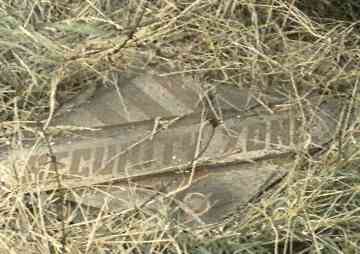
| Defence area around the entrance to Central Control on Earth, with hidden surveillance cameras and a lethal, high intensity radiation grid covering an area about 50 yards around the bunker entrance. The grid could apparently root people to the spot, preventing their escape, and was self-repairing in eight seconds. |  |
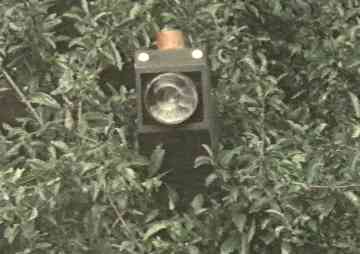 | Avon supposed that the bunker might also be fitted with antimatter screening. Arle and Berg died in the Forbidden Zone after stepping on the grid; Blake, Avon, Vila and Gan blasted a way through. Servalan used her authority to have the grid deactivated, allowing Travis and two mutoids access to the bunker. She later followed herself, held at gunpoint by Jenna and Veron. |
Inventor of Pylene-50, and keeper of the formula. Servalan kept him working for her by poisoning him with tincture of pyrhennic, an extract of pamperanian fungi, but eventually killed him after he tried to kill himself and her with his "primitive nitroglycerine". Forbus also developed an antidote to Pylene-50, which he gave to Tarrant and Dayna, and it was he who led them to realise that Leitz was a traitor.
Like a number of people encountered by the crew, Forbus had heard of the Liberator and also knew of Dayna and Tarrant by name.
A number of force fields - called by various names - were encountered in seventeen episodes. They consisted of two types: those that protected planets or planetary installations, and those that protected spaceships. Those of the former type appeared in the following six episodes:
In Orac, Ensor's hideaway was protacted by a 'surface force barrier' (Servalan), which forced Servalan and Travis to go under it to get there, via the tunnels under the old city. Once disconnected, the 'force barrier' (Blake) took five hours to dissipate. Also, signal transmissions through the 'energy screen' (Orac) were not possible.
In Voice from the Past, 'security force walls' were present around Atlay as part of the security arrangements for the governors' conference.
In Star One, the computer complex was 'shielded', making it impossible for Vila to teleport Blake and Cally once they were inside.
In City at the Edge of the World, two of the most sophisticated force fields in the series were encountered. The first protected a vault in a city on Kezarn. It was designed to refract light, giving the appearance of a door. This afforded the vault extra protection, as those before Vila incorrectly assumed that it was a solid object. He found that the force field's energy threshold was 002; so he set up a low energy probe to push a probe into the force field at a maximum energy of 001, correctly predicting that this would cause the latter's collapse.
Vila and Kerril encountered the second force field aboard a starship, protecting an exit. While designed by the same person, it was slightly different, refracting light at the same frequency as the wall, rendering it invisible, ensuring that those on board the ship did nothing rash, like attacking the weakest point in the wall.
This episode is of interest due to the remarks made by Vila to Kerril about the nature of force fields in general. First, he explained that all force fields feel solid; the designer in the case of the first force field simply used the refraction of light to also give the appearance of a solid object.
Second, he explained why the methods previously used to break through failed, because 'like all force fields, whatever energy you push into it, it chucks right back at you. For all energy input, there has to be an equal and opposite energy output. Result - an indestructible block'. Lastly, he was able to figure out that some kind of exit from the starship existed, protected by a force field, as 'Air can bleed through a force field'.
In Headhunter, Muller told Tarrant that direct teleportation into his laboratory was possible, as it was not 'shielded'.
In Games, Belkov claimed that by using the Feldon crystals on Orbiter and reflectors on the moon, he could set up 'a series of force fields' to keep Scorpio from leaving Mecron 2's orbit; but this described what Avon correctly identified as 'Multiple traction beams'.
Of the force fields used to protect spaceships, the one most frequently used in the series was that which protected the Liberator - called the 'force wall' - used in nine episodes. Notable uses were as follows:
Mission to Destiny: The force wall was first mentioned in this episode, when a meteorite storm was encountered. Questioned as to whether the force wall would hold, Zen replied that the storm was within the 'maximum design tolerance' but with 'no safety margin', being unable to say if there was sufficient reserve power to maintain the wall. At about halfway through the storm, Gan remarked that the force wall was eating into the ship's power reserves. Zen them warned that in 1.03 minutes it would be impossible to operate the force wall and main drive simultaneously, Blake then deciding to deactivate the former.
Duel: The forcewall was first used in combat in this episode. When the first Federation plasma bolt was launched, Jenna ordered the force wall's activation; but Blake countermanded this, saying that it was 'too much of an energy drain'; and he ordered its activation only a short time before the bolt struck. After it hit, he ordered the wall's deactivation. This went on for eight more bolts, till Blake decided to ram Travis's ship. Gan wondered if the force wall could withstand a salvo of four plasma bolts, which were fired; but the question was rendered academic due to the intervention of Sinofar and Giroc.
Horizon: The force wall ensured that the Liberator was not destroyed by the Federation's magnetic barrier protecting Horizon.
Hostage: When facing a surprise second Federation attack, by twenty ships, Blake ordered 'Activate force wall 360'. He also asked if the power reserves were switched in, Jenna confirming that they were.
Dawn of the Gods: Avon ordered Zen to activate the force wall when the latter identified a dust cloud of intensity 6 in the ship's flight path, Tarrant remarking that they couldn't afford a drain on the energy banks. Later, Zen predicted that the force wall's collapse was imminent, as the Liberator's velocity was 'in excess of design limitations', which soon happened, damaging the outer teleport transducers.
The Harvest of Kairos: In this episode, two interesting properties of the Liberator's force wall were revealed. First, the ship could attack through its force wall, Servalan's remark that this was 'absurd' revealing that other spaceship force fields didn't have this ability. Also, the force wall could be brought to 'maximum deflection' on either 'interlock' or 'overlap'. Dayna's inability to do 'overlap' ensured that the Liberator's keel section was damaged.
A few conclusions can be suggested about this particular force wall. First, it only reduced the amount of damage inflicted on the Liberator, which , as particularly shown in Hostage and Volcano, could be considerable. It therefore must have operated on a different principle to the force fields described by Vila in City. Second, its use was a heavy drain on the ship's energy banks; so only sections must have been activated to conserve power, as the full force wall seemed to only be activated against all out attacks, like in Hostage. Third, it could be activated and deactivated either by Zen or by members of the crew, although it would have presumably been more efficient to use the former.
At least some other ships, particularly Federation, also had force fields for protection. The pursuit ships in Duel had such a force field, a mutoid commenting that if Pursuit Three continued firing, 'it won't have enough reserve to put up its defence shield'. Like the Liberator's force wall, such a force fleld appeared to be a heavy drain on the ship's energy banks. In Children of Auron, Pilot 4-0 was told by Servalan that her ship had also hit a 'random ionic reef' but with its 'force shields up'.
In Stardrive, Scorpio collided with an asteroid, resulting in the need to repair the main drive's focusing core; but the main drive chamber was not pressurised, and the repair too delicate to perform in spacesuits. Vila said that when he was first sent to a penal colony at 14, his ship was hit in the main drive by a meteoroid; and the repair was effected by activating the ship's force wall, and generating an atmosphere inside, so the repair team could work in a vacuun without spacesuits. Slave was able to manage a 'small force wall', a 'blister force wall', around the damaged part of Scorpio's hull, enabling the repair to be carried out.
See FORCE FIELDS.
| Section Leader working with Major Grenlee in seeing to security around Residence 1 on Earth. A popular saying from where he came from (possibly another planet) was "Some days are better than others", and he claimed that his mother cried the day he left home because he "owed her money". He was killed by Sula's rebels when they broke into the residence. | 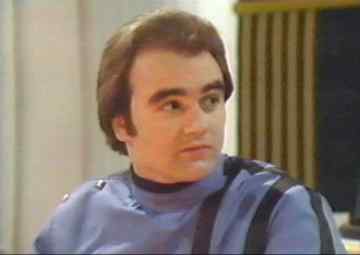 |
Severed by Cally whilst under the influence of the Lost, leaving Liberator blind and forcing Zen to turn to theoretical projection for navigation. Cally's sabotage was carried out in the teleport area.
|
The Federation maintained a Q-base on Fosforon, and Blake visited the planet
to acquire a TP crystal. Blake's comments about Wanderer K47 suggest
that the planet was within 3,000 light years of Earth. The high oxygen
content of the atmosphere made fire a particular hazard on the base. A
plague designed to kill any human who had suffered the Terran Ague broke
loose on Fosforon and killed everyone there. Blake put out a plague warning
transmitter, despite Servalan's imminent arrival.
| 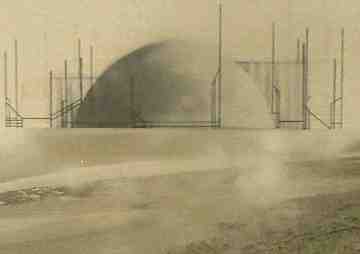 |
| Resistance leader who had known Blake four years previously prior to his arrest and trial. At this time he had presumably been working on Earth, but Richie mentioned that he had recently been on Ziegler-5. Blake did not recognise him when they next met. Foster told Blake some details of his past, opening up some of the sealed off areas in Blake's mind. Despite insisting on not resorting to violence or resisting arrest, he was shot dead by the security forces (the first person at the illegal meeting to be killed). | 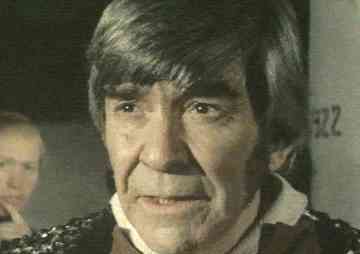 |
[1] Pioneer of cloning and spontaneous cell differentiation on Auron, and an opponent of Auron's isolationist policy. Ginka referred to him having died "several years ago".
[2] Daughter of the above, who continued with her father's work. She was born naturally, before the replication process was perfected, and was thus presumably not telepathic. In charge of the replication plant at the time of Avon's visit, it was Franton who persuaded CA 1 that Zelda should contact Cally aboard the Liberator to seek help against Servalan's plague. She contracted the plague herself, but was cured on Servalan's ship (the first person to be cured of the plague). Having rescued Avon, Cally and Tarrant from Servalan's guards in the control centre. she left Auron with Patar and gene stocks for 5,000 offspring, and presumably arrived safely at the planet Kahn.